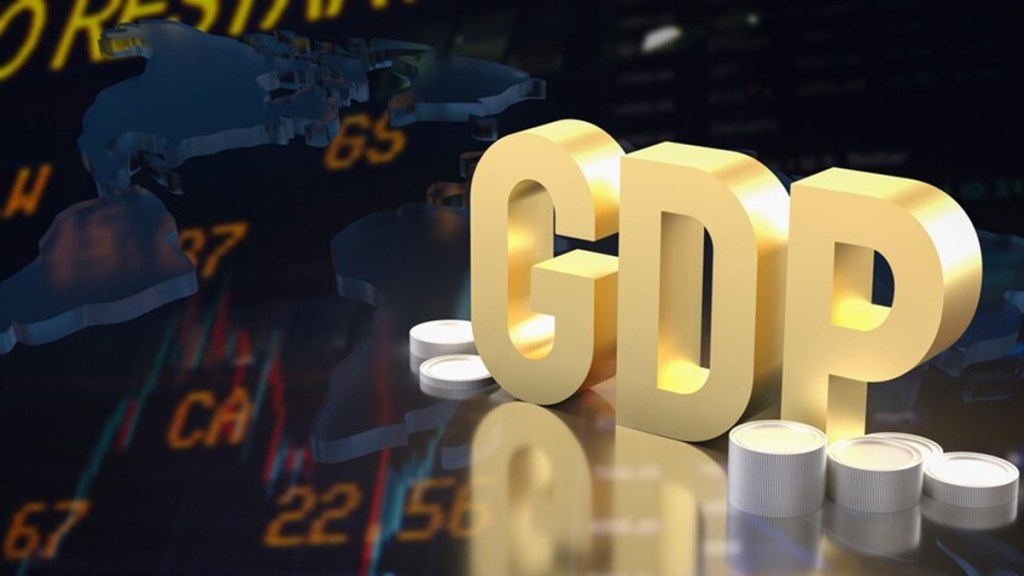India’s economic growth fell to 7.4% in the fourth quarter of 2024-25, from 8.4% in the year-ago quarter, as manufacturing, private and government consumption, and key services slowed, according to provisional estimates released by the National Statistics Office (NSO) on Friday.
For the whole of FY25, the GDP expansion slowed to a four-year low of 6.5%, compared with 9.2% in the previous year.
The latest quarterly GDP was still better than analyst estimates, which hovered around 6.8-6.9%, and came almost in line with the NSO’s second advance estimates published on February 28. An upward revision of Q3FY25 GDP growth from 6.2% to 6.4% helped the annual economic expansion to be the same as in second advance estimates.
A solid pick-up in construction, a steady primary sector and a rare and big push from “net exports”, which accounted for 3.7% of the GDP, helped the Q4 growth rate beat estimates.
The Q4 GDP also got a boost from net indirect taxes – the gross value added (GVA), a better indicator of economic momentum, grew at a lower rate of 6.8% in the quarter.
During FY25, private consumption raised its share in the GDP marginally to 56.5% from 56.1% in previous year. But the growth of this largest component of the economy fell both annually and on a sequential basis in the fourth quarter. High-frequency indicators in the current quarter reflect only a further downslide thereafter.
Gross fixed capital formation, a proxy of investment demand, grew a robust 9.4% in Q4, while in the whole of the last fiscal, it expanded by 7.1%.
The primary sector comprising agriculture and mining did well (4.4%) in FY25 by its standards. They held up in the last two quarters of the year with growth of 6.1% and 5% respectively, mainly on the strength of the farm sector. With record food grains production predicted for the upcoming kharif season and above-normal monsoon, farming prospects could remain bright in the current fiscal too.
For the current year, however, many analysts see the growth to slip below 6.5%, given the severe external headwinds. The finance ministry, in its latest monthly report, expressed hope that income tax cuts in the FY26 Budget, coupled with the possibility of more rate cuts by the Reserve Bank of India in a benign inflation scenario would stimulate consumption and investment to lift FY26 growth towards the upper end of its forecast range of 6.3-6.8%.
The supply chain rejig under way owing to the tariff tensions, possible gains from China+1 strategy and the chances of the soon-to-be-inked trade agreement with the US “flipping the headwinds to tailwinds” are the reasons for the optimism.
The need for key structural changes in the economy and better coordination between the Union and state governments is being felt.
Nominal growth in FY25 came in at 9.8%, marginally higher than budgeted 9.7%, letting the Union government meet the revised estimate (4.8%) of the fiscal deficit easily.
From the production side, agriculture GVA grew 5.4% in Q4 compared with 0.9% in the year ago quarter. The construction-sector GVA expanded at 10.8% in Q4 compared with 8.7% in Q4 of FY24.
The third biggest contributor to the economy from the output side — the manufacturing sector — saw its growth slowing to 4.8% from 11.3% a year ago. “Financial, real estate and professional services” growth was down to 7.8% from 9%. while “trade, hotels, transport, communications, etc” expanded at 6%, marginally lower than 6.2% a year ago.
“Consumption growth outpaced GDP, primarily driven by robust rural demand supported by a strong agricultural sector. A sharp catchup in investment growth in the last quarter also brought annual investment growth above GDP growth,” notes DK Joshi, chief economist at Crisil. He, however, fears investment demand might remain sluggish, “as elevated uncertainty will dampen corporate investment appetite, and public investment is planned to grow at a slower rate compared to fiscal 2025.”
FY25 saw a showdown in the Centre’s capital expenditure at 10.8%, compared with a healthy average of around 31% in the three years through FY24. Government final consumption expenditure contracted in Q4 (-1.8%, after a gap of two quarters.
“At present, ICRA forecasts GDP growth to dip slightly to 6.2% in FY26,” Aditi Nayar, chief economist at Icra.
“Going forward, while the good monsoon, monetary easing and declining inflation have brightened the prospects of another year of robust consumption growth. Investment outlook is still hazy,” associate director at India Ratings Paras Jasrai says.
The global tariff war might weigh on private investment growth. Economists expect growth in the current fiscal year to be between 6.2% to 6.5%. The RBI has projected an expansion of 6.5%.

